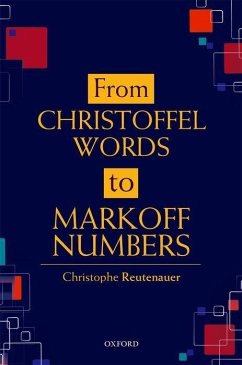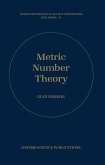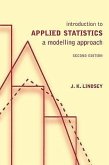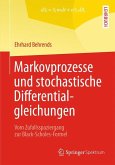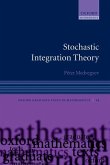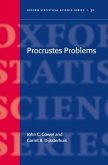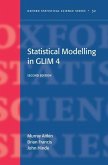Christophe Reutenauer
From Christoffel Words to Markoff Numbers
Christophe Reutenauer
From Christoffel Words to Markoff Numbers
- Gebundenes Buch
- Merkliste
- Auf die Merkliste
- Bewerten Bewerten
- Teilen
- Produkt teilen
- Produkterinnerung
- Produkterinnerung
This book looks to expand on the relationship between Christoffel words and Markoff theory. Part 1 focuses on the classical theory of Markoff, while part II explores the more advanced and recent results around Christoffel words.
Andere Kunden interessierten sich auch für
![Metric Number Theory Metric Number Theory]() Glyn HarmanMetric Number Theory397,99 €
Glyn HarmanMetric Number Theory397,99 €![Introduction to Applied Statistics Introduction to Applied Statistics]() J K LindseyIntroduction to Applied Statistics95,99 €
J K LindseyIntroduction to Applied Statistics95,99 €![Markovprozesse und stochastische Differentialgleichungen Markovprozesse und stochastische Differentialgleichungen]() Ehrhard BehrendsMarkovprozesse und stochastische Differentialgleichungen25,00 €
Ehrhard BehrendsMarkovprozesse und stochastische Differentialgleichungen25,00 €![Introduction to Modern Analysis Introduction to Modern Analysis]() Shmuel KantorovitzIntroduction to Modern Analysis161,99 €
Shmuel KantorovitzIntroduction to Modern Analysis161,99 €![Stochastic Integration Theory Stochastic Integration Theory]() Peter MedvegyevStochastic Integration Theory162,99 €
Peter MedvegyevStochastic Integration Theory162,99 €![Procrustes Problems Procrustes Problems]() John C GowerProcrustes Problems236,99 €
John C GowerProcrustes Problems236,99 €![Statistical Modelling in Glim4 Statistical Modelling in Glim4]() Murray AitkinStatistical Modelling in Glim484,99 €
Murray AitkinStatistical Modelling in Glim484,99 €-
-
-
This book looks to expand on the relationship between Christoffel words and Markoff theory. Part 1 focuses on the classical theory of Markoff, while part II explores the more advanced and recent results around Christoffel words.
Hinweis: Dieser Artikel kann nur an eine deutsche Lieferadresse ausgeliefert werden.
Hinweis: Dieser Artikel kann nur an eine deutsche Lieferadresse ausgeliefert werden.
Produktdetails
- Produktdetails
- Verlag: Hurst & Co.
- Seitenzahl: 170
- Erscheinungstermin: 15. Januar 2019
- Englisch
- Abmessung: 236mm x 155mm x 15mm
- Gewicht: 408g
- ISBN-13: 9780198827542
- ISBN-10: 0198827547
- Artikelnr.: 52962165
- Herstellerkennzeichnung
- Libri GmbH
- Europaallee 1
- 36244 Bad Hersfeld
- gpsr@libri.de
- Verlag: Hurst & Co.
- Seitenzahl: 170
- Erscheinungstermin: 15. Januar 2019
- Englisch
- Abmessung: 236mm x 155mm x 15mm
- Gewicht: 408g
- ISBN-13: 9780198827542
- ISBN-10: 0198827547
- Artikelnr.: 52962165
- Herstellerkennzeichnung
- Libri GmbH
- Europaallee 1
- 36244 Bad Hersfeld
- gpsr@libri.de
Christophe Reutenauer was educated at the Université Paris in 1977 before going on to complete his doctorate thesis at the same institution in 1980. He was a former researcher at CNRS (Centre National de la Recherche Scientifique) in Paris and LITP (Laboratoire d'Informatique Théorique et de Programmation) from 1976 to 1990. Reutenauer has, from 1985, been a professor at UQAM (Université du Québec à Montréal), and was also a professor at the University of Strasbourg between 1999 and 2001. Since then, he has been an invited professor or researcher at several universities, including Saarbrücken, Darmstadt, Roma, Napoli, Palermo, UQAM, San Diego (UCSD), Strasbourg, Montpelier, Bordeaux, Paris-Est, Nice, and the Mittag-Leffler Institute. He was also the Canadian Research Chair for "Algebra, Combinatorics and mathematical Informatics" between 2001 and 2015.
The Theory of Markoff
1: Basics
2: Words
2.1: Tiling the plane with a parallelogram
2.2: Christoffel words
2.3: Palindromes
2.4: Standard factorization
2.5: The tree of Christoffel pairs
2.6: Sturmian morphisms
3: Markoff numbers
3.1: Markoff triples and numbers
3.2: The tree of Markoff triples
3.3: The Markoff injectivity conjecture
4: The Markoff property
4.1: Markoff property for infinite words
4.2: Markoff property for bi-infinite words
5: Continued fractions
5.1: Finite continued fractions
5.2: Infinite continued fractions
5.3: Periodic expansions yield quadratic numbers
5.4: Approximations of real numbers
5.5: Lagrange number of a real number
5.6: Ordering continued fractions
6: Words and quadratic numbers
6.1: Continued fractions associated to Christoffel words
6.2: Marko supremum of a bi-innite sequence
6.3: Lagrange number of a sequence
7: Lagrange numbers less than 3
7.1: From L(s) < 3 to the Marko property
7.2: Bi-infinite sequences
8: Markoff's theorem for approximations
8.1: Main lemma
8.2: Markoff's theorem for approximations
8.3: Good and bad approximations
9: Markoff's theorem for quadratic forms
9.1: Indefinite real binary quadratic forms
9.2: Infimum
9.3: Markoff's theorem for quadratic forms
10: Numerology
10.1: Thirteen Markoff numbers
10.2: The golden ratio and other numbers
10.3: The matrices U(w) and Frobenius congruences
10.4: Markoff quadratic forms
11: Historical notes
The Theory of Christoel Words
12: Palindromes and periods
12.1: Palindromes
12.2: Periods
13: Lyndon words and Christoffel words
13.1: Slopes
13.2: Lyndon words
13.3: Maximal Lyndon words
13.4: Unbordered Sturmian words
13.5: Equilibrated Lyndon words
14: Stern-Brocot tree
14.1: The tree of Christoffel words
14.2: Stern-Brocot tree and continued fractions
14.3: The Raney tree and dual words
14.4: Convex hull
15: Conjugates and factors
15.1: Cayley graph
15.2: Conjugates
15.3: Factors
15.4: Palindromes again
15.5: Finite Sturmian words
16: Free group on two generators
16.1: Bases and automorphisms
16.2: Inner automorphisms
16.3: Christoffel bases
16.4: Nielsen's criterion
16.5: An algorithm for the bases
16.6: Sturmian morphisms again
17: Complements
17.1: Other results on Christoffel words
17.2: Lyndon words and Lie theory
17.3: Music
1: Basics
2: Words
2.1: Tiling the plane with a parallelogram
2.2: Christoffel words
2.3: Palindromes
2.4: Standard factorization
2.5: The tree of Christoffel pairs
2.6: Sturmian morphisms
3: Markoff numbers
3.1: Markoff triples and numbers
3.2: The tree of Markoff triples
3.3: The Markoff injectivity conjecture
4: The Markoff property
4.1: Markoff property for infinite words
4.2: Markoff property for bi-infinite words
5: Continued fractions
5.1: Finite continued fractions
5.2: Infinite continued fractions
5.3: Periodic expansions yield quadratic numbers
5.4: Approximations of real numbers
5.5: Lagrange number of a real number
5.6: Ordering continued fractions
6: Words and quadratic numbers
6.1: Continued fractions associated to Christoffel words
6.2: Marko supremum of a bi-innite sequence
6.3: Lagrange number of a sequence
7: Lagrange numbers less than 3
7.1: From L(s) < 3 to the Marko property
7.2: Bi-infinite sequences
8: Markoff's theorem for approximations
8.1: Main lemma
8.2: Markoff's theorem for approximations
8.3: Good and bad approximations
9: Markoff's theorem for quadratic forms
9.1: Indefinite real binary quadratic forms
9.2: Infimum
9.3: Markoff's theorem for quadratic forms
10: Numerology
10.1: Thirteen Markoff numbers
10.2: The golden ratio and other numbers
10.3: The matrices U(w) and Frobenius congruences
10.4: Markoff quadratic forms
11: Historical notes
The Theory of Christoel Words
12: Palindromes and periods
12.1: Palindromes
12.2: Periods
13: Lyndon words and Christoffel words
13.1: Slopes
13.2: Lyndon words
13.3: Maximal Lyndon words
13.4: Unbordered Sturmian words
13.5: Equilibrated Lyndon words
14: Stern-Brocot tree
14.1: The tree of Christoffel words
14.2: Stern-Brocot tree and continued fractions
14.3: The Raney tree and dual words
14.4: Convex hull
15: Conjugates and factors
15.1: Cayley graph
15.2: Conjugates
15.3: Factors
15.4: Palindromes again
15.5: Finite Sturmian words
16: Free group on two generators
16.1: Bases and automorphisms
16.2: Inner automorphisms
16.3: Christoffel bases
16.4: Nielsen's criterion
16.5: An algorithm for the bases
16.6: Sturmian morphisms again
17: Complements
17.1: Other results on Christoffel words
17.2: Lyndon words and Lie theory
17.3: Music
The Theory of Markoff
1: Basics
2: Words
2.1: Tiling the plane with a parallelogram
2.2: Christoffel words
2.3: Palindromes
2.4: Standard factorization
2.5: The tree of Christoffel pairs
2.6: Sturmian morphisms
3: Markoff numbers
3.1: Markoff triples and numbers
3.2: The tree of Markoff triples
3.3: The Markoff injectivity conjecture
4: The Markoff property
4.1: Markoff property for infinite words
4.2: Markoff property for bi-infinite words
5: Continued fractions
5.1: Finite continued fractions
5.2: Infinite continued fractions
5.3: Periodic expansions yield quadratic numbers
5.4: Approximations of real numbers
5.5: Lagrange number of a real number
5.6: Ordering continued fractions
6: Words and quadratic numbers
6.1: Continued fractions associated to Christoffel words
6.2: Marko supremum of a bi-innite sequence
6.3: Lagrange number of a sequence
7: Lagrange numbers less than 3
7.1: From L(s) < 3 to the Marko property
7.2: Bi-infinite sequences
8: Markoff's theorem for approximations
8.1: Main lemma
8.2: Markoff's theorem for approximations
8.3: Good and bad approximations
9: Markoff's theorem for quadratic forms
9.1: Indefinite real binary quadratic forms
9.2: Infimum
9.3: Markoff's theorem for quadratic forms
10: Numerology
10.1: Thirteen Markoff numbers
10.2: The golden ratio and other numbers
10.3: The matrices U(w) and Frobenius congruences
10.4: Markoff quadratic forms
11: Historical notes
The Theory of Christoel Words
12: Palindromes and periods
12.1: Palindromes
12.2: Periods
13: Lyndon words and Christoffel words
13.1: Slopes
13.2: Lyndon words
13.3: Maximal Lyndon words
13.4: Unbordered Sturmian words
13.5: Equilibrated Lyndon words
14: Stern-Brocot tree
14.1: The tree of Christoffel words
14.2: Stern-Brocot tree and continued fractions
14.3: The Raney tree and dual words
14.4: Convex hull
15: Conjugates and factors
15.1: Cayley graph
15.2: Conjugates
15.3: Factors
15.4: Palindromes again
15.5: Finite Sturmian words
16: Free group on two generators
16.1: Bases and automorphisms
16.2: Inner automorphisms
16.3: Christoffel bases
16.4: Nielsen's criterion
16.5: An algorithm for the bases
16.6: Sturmian morphisms again
17: Complements
17.1: Other results on Christoffel words
17.2: Lyndon words and Lie theory
17.3: Music
1: Basics
2: Words
2.1: Tiling the plane with a parallelogram
2.2: Christoffel words
2.3: Palindromes
2.4: Standard factorization
2.5: The tree of Christoffel pairs
2.6: Sturmian morphisms
3: Markoff numbers
3.1: Markoff triples and numbers
3.2: The tree of Markoff triples
3.3: The Markoff injectivity conjecture
4: The Markoff property
4.1: Markoff property for infinite words
4.2: Markoff property for bi-infinite words
5: Continued fractions
5.1: Finite continued fractions
5.2: Infinite continued fractions
5.3: Periodic expansions yield quadratic numbers
5.4: Approximations of real numbers
5.5: Lagrange number of a real number
5.6: Ordering continued fractions
6: Words and quadratic numbers
6.1: Continued fractions associated to Christoffel words
6.2: Marko supremum of a bi-innite sequence
6.3: Lagrange number of a sequence
7: Lagrange numbers less than 3
7.1: From L(s) < 3 to the Marko property
7.2: Bi-infinite sequences
8: Markoff's theorem for approximations
8.1: Main lemma
8.2: Markoff's theorem for approximations
8.3: Good and bad approximations
9: Markoff's theorem for quadratic forms
9.1: Indefinite real binary quadratic forms
9.2: Infimum
9.3: Markoff's theorem for quadratic forms
10: Numerology
10.1: Thirteen Markoff numbers
10.2: The golden ratio and other numbers
10.3: The matrices U(w) and Frobenius congruences
10.4: Markoff quadratic forms
11: Historical notes
The Theory of Christoel Words
12: Palindromes and periods
12.1: Palindromes
12.2: Periods
13: Lyndon words and Christoffel words
13.1: Slopes
13.2: Lyndon words
13.3: Maximal Lyndon words
13.4: Unbordered Sturmian words
13.5: Equilibrated Lyndon words
14: Stern-Brocot tree
14.1: The tree of Christoffel words
14.2: Stern-Brocot tree and continued fractions
14.3: The Raney tree and dual words
14.4: Convex hull
15: Conjugates and factors
15.1: Cayley graph
15.2: Conjugates
15.3: Factors
15.4: Palindromes again
15.5: Finite Sturmian words
16: Free group on two generators
16.1: Bases and automorphisms
16.2: Inner automorphisms
16.3: Christoffel bases
16.4: Nielsen's criterion
16.5: An algorithm for the bases
16.6: Sturmian morphisms again
17: Complements
17.1: Other results on Christoffel words
17.2: Lyndon words and Lie theory
17.3: Music

